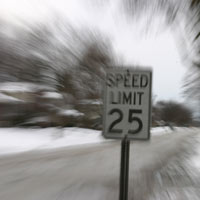Understanding the Dangers of Speeding
August 14, 2018 Speeding is one of the most common causes of car accidents. In fact, according to the National Highway Transportation Safety Administration (NHTSA), speeding was responsible for over 10,000 fatalities in 2016 alone.
Speeding is one of the most common causes of car accidents. In fact, according to the National Highway Transportation Safety Administration (NHTSA), speeding was responsible for over 10,000 fatalities in 2016 alone.
It can be tempting to exceed the speed limit, particularly when you are running late, or are in a rush to get somewhere. However, the more you understand about the science behind speeding, and the damage that a speeding car can cause upon impact, the more likely you may be to slow down, be patient, and observe the posted speed limits. They are there for a reason.
The Dynamics of a Car Accident
Kinetic energy is an important factor to understand when considering the science behind a car accident. Kinetic energy is motion related energy. When an object has greater mass and speed – like a car that is driving too fast – that object has more kinetic energy.
To put this in the form of an equation, kinetic energy is equal to half of the mass times the squared velocity. For example, if a 4,400-lb car is driving at approximately 22 mph, there would be 100,000 Joules of kinetic energy. If the speed was doubled to 45 mph, the kinetic energy would be 400,000 Joules. In other words, doubling the speed increases the force of the collision by four times, making a speed-related accident potentially much more dangerous.
Clearly, a speeding car is going to cause more property damage and more severe injuries than if the vehicle was travelling at a slower speed. It is important to understand that the difference between being able to walk away from a car accident and being carried away in an ambulance is closely related to the length of time of impact during the crash.
Speeding Impacts Safety Equipment Effectiveness
If the car was speeding at the time of the crash, there is less time for the vehicle’s safety devices to absorb the energy from the crash. An example of such a safety device is the vehicle’s crumple zones, which are sections of the car that are designed to absorb energy from the impact, causing it to crumple up. Another example are air bags, which also extend the time of impact and protect the passengers inside the vehicle.
Keep this information in mind the next time you hit the gas pedal. When you drive within the speed limit, there is a better chance that your car will be able to absorb the energy of the impact. This means that your injuries are likely to be less severe, as is the damage to your vehicle.
Getting somewhere a few minutes sooner is not worth the risk of causing a car accident that could result in serious injuries to you, the other passengers in your vehicle, and any other motorists involved in the accident.
Baltimore Car Accident Lawyers at LeViness, Tolzman & Hamilton Seek Justice for Victims of Speeding Accidents
If you have been injured in a car accident involving another driver who was speeding, the Baltimore car accident lawyers at LeViness, Tolzman & Hamilton are on your side. We will secure the maximum financial compensation you deserve for your injuries, ensuring that your legal rights are protected at all times. To schedule a free, confidential consultation, call us today at 800-547-4LAW (4529) or contact us online.
Our offices are located in Baltimore, Columbia, Glen Burnie, and Towson, allowing us to represent car accident victims in Maryland, including those in Anne Arundel County, Baltimore County, Carroll County, Harford County, Howard County, Montgomery County, Maryland’s Western Counties, Prince George’s County, Queen Anne’s County, Southern Maryland, and the Eastern Shore, as well as the communities of Catonsville, Essex, Halethorpe, Middle River, Rosedale, Gwynn Oak, Brooklandville, Dundalk, Pikesville, Nottingham, Windsor Mill, Lutherville, Timonium, Sparrows Point, Ridgewood, and Elkridge.






